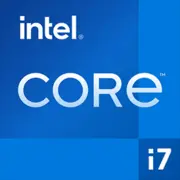AMD Ryzen 5 8500G vs Intel Core i7-14700K
CPU Comparison Result
Below are the results of a comparison of
AMD Ryzen 5 8500G
and
Intel Core i7-14700K
processors based on key performance characteristics, as well as power consumption and much more.
Advantages
- Higher Technology: 7 nm (7 nm vs 10 nm)
- Newer Launch Date: January 2024 (January 2024 vs October 2023)
- More Total Cores: 20 (6 vs 20)
- Higher Performance-core Max Turbo Frequency: 5.6 GHz (5.0 GHz vs 5.6 GHz)
- Larger L3 Cache: 33MB (16MB shared vs 33MB)
- Higher Memory Type: DDR5-5600 (DDR4-3200 vs DDR5-5600)
Basic
AMD
Label Name
Intel
January 2024
Launch Date
October 2023
Desktop
Platform
Desktop
Ryzen 5 8500G
Model Name
?
The Intel processor number is just one of several factors - along with processor brand, system configurations, and system-level benchmarks - to be considered when choosing the right processor for your computing needs.
i7-14700K
Zen 4 (Phoenix)
Code Name
Raptor Lake Refresh
CPU Specifications
6
Total Cores
?
Cores is a hardware term that describes the number of independent central processing units in a single computing component (die or chip).
20
12
Total Threads
?
Where applicable, Intel® Hyper-Threading Technology is only available on Performance-cores.
28
2
Performance-cores
8
4
Efficient-cores
12
3.55 GHz
Performance-core Base Frequency
3.4 GHz
-
Efficient-core Base Frequency
2.5 GHz
5.0 GHz
Performance-core Max Turbo Frequency
?
Maximum P-core turbo frequency derived from Intel® Turbo Boost Technology.
5.6 GHz
64K per core
L1 Cache
80K per core
512K per core
L2 Cache
28MB
16MB shared
L3 Cache
33MB
AM5
CPU Socket
?
The socket is the component that provides the mechanical and electrical connections between the processor and motherboard.
LGA-1700
7 nm
Technology
?
Lithography refers to the semiconductor technology used to manufacture an integrated circuit, and is reported in nanometer (nm), indicative of the size of features built on the semiconductor.
10 nm
65 W
TDP
125 W
95 °C
Max. Operating Temperature
?
Junction Temperature is the maximum temperature allowed at the processor die.
100°C
Memory Specifications
DDR4-3200
Memory Type
?
Intel® processors come in four different types: Single Channel, Dual Channel, Triple Channel, and Flex Mode. Maximum supported memory speed may be lower when populating multiple DIMMs per channel on products that support multiple memory channels.
DDR5-5600
128GB
Max Memory Size
?
Max memory size refers to the maximum memory capacity supported by the processor.
192GB
2
Memory Channels
?
The number of memory channels refers to the bandwidth operation for real world application.
2
GPU Specifications
True
Integrated Graphics Model
?
An integrated GPU refers to the graphics core that is integrated into the CPU processor. Leveraging the processor's powerful computational capabilities and intelligent power efficiency management, it delivers outstanding graphics performance and a smooth application experience at a lower power consumption.
True
Benchmarks
Geekbench 6 Single Core
Ryzen 5 8500G
2345
Core i7-14700K
2936
+25%
Geekbench 6 Multi Core
Ryzen 5 8500G
10568
Core i7-14700K
20992
+99%
Geekbench 5 Single Core
Ryzen 5 8500G
1965
Core i7-14700K
2185
+11%
Geekbench 5 Multi Core
Ryzen 5 8500G
8768
Core i7-14700K
22625
+158%
Passmark CPU Single Core
Ryzen 5 8500G
3903
Core i7-14700K
4479
+15%
Passmark CPU Multi Core
Ryzen 5 8500G
21687
Core i7-14700K
53645
+147%






